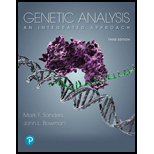
What are the advantages and disadvantages of using GFP versus lacZ as a reporter gene in mice, C. elegans, and Drosopholia?
To analyze:
Describe the advantages and disadvantages of using GFP versus lacZ as a reporter gene in mice, C. elegans, and Drosophila.
Introduction:
A gene which is involved to a regulatory arrangement of another gene of courtesy in studying cell culture, animals, plants, or bacteria is known as a reporter gene. These genes are used as an indication of whether a certain gene has been retained or stated by a cell in a population of cells. Commonly used reporter genes include GFP, GUS, lacZ, etc.
Explanation of Solution
LacZ gene from E. coli is used as a reporter gene. But to observe its activity and give accurate results, the cell under study must take up X-gal from the medium, and it is a lengthy process with uncertainty of results. Therefore, many researchers now use GFP as a reporter gene.
Green fluorescent protein (GFP) is one of the fluorescent reporters used for screening of genetic expression in organisms like mice, C. elegans, and Drosophila. Genes encoding GFP are obtained from the jellyfish – Aequorid victoria.
Advantages of using GFP versus lacZ include the following:
Screening of living transgenic cells or organisms can be easily performed by just observing luminescent cells in a population.
Fusion of gene of interest with GFP gene does not affect its luminescent property. Therefore, results are accurate.
Disadvantages of using GFP versus lacZ include the following:
Size of GFP is larger. It may affect the function of protein of interest. This does not occur when lacZ is used as a reporter gene.
Advantages and disadvantages of using GFP versus lacZ as a reporter gene in mice, C. elegans, and Drosophila are described above, Green fluorescent protein (GFP) is one of the fluorescent reporters used for screening of genetic expression whereas lac Z activity and accuracy determination is an lengthy process.
Want to see more full solutions like this?
Chapter 14 Solutions
Genetic Analysis: An Integrated Approach (3rd Edition)
- How is a protein destined for the Endoplasmic Reticulum (ER), imported into the ER? Be concise.arrow_forwardFind out about the organisations and the movements aimed at the conservation of our natural resources. Eg Chipko movement and Greenpeace. Make a project report on such an organisation.arrow_forwardWhat are biofertilizers and mention the significancearrow_forward
- PCBs and River Otters: Otters in Washington State’s Green-Duwamish River have high levels of polychlorinated biphenyls (PCBs) in their livers. PCBs can bind to the estrogen receptors in animals and disrupt the endocrine system of these otters. The PCBs seem to increase the estrogen to androgen ratio, skewing the ratio toward too much estrogen. How would increased estrogen affect the river otter population? Based on your reading of the materials in this unit, what factors can affect fertility in humans? Explain how each of the factors affecting human fertility that you described can disrupt the human endocrine system to affect reproduction.arrow_forwardOther than oil and alcohol, are there other liquids you could compare to water (that are liquid at room temperature)? How is water unique compared to these other liquids? What follow-up experiment would you like to do, and how would you relate it to your life?arrow_forwardSelection of Traits What adaptations do scavengers have for locating and feeding on prey? What adaptations do predators have for capturing and consuming prey?arrow_forward
- Competition Between Species What natural processes limit populations from growing too large? What are some resources organisms can compete over in their natural habitat?arrow_forwardSpecies Interactions Explain how predators, prey and scavengers interact. Explain whether predators and scavengers are necessary or beneficial for an ecosystem.arrow_forwardmagine that you are conducting research on fruit type and seed dispersal. You submitted a paper to a peer-reviewed journal that addresses the factors that impact fruit type and seed dispersal mechanisms in plants of Central America. The editor of the journal communicates that your paper may be published if you make ‘minor revisions’ to the document. Describe two characteristics that you would expect in seeds that are dispersed by the wind. Contrast this with what you would expect for seeds that are gathered, buried or eaten by animals, and explain why they are different. (Editor’s note: Providing this information in your discussion will help readers to consider the significance of the research).arrow_forward
 Biology: The Dynamic Science (MindTap Course List)BiologyISBN:9781305389892Author:Peter J. Russell, Paul E. Hertz, Beverly McMillanPublisher:Cengage Learning
Biology: The Dynamic Science (MindTap Course List)BiologyISBN:9781305389892Author:Peter J. Russell, Paul E. Hertz, Beverly McMillanPublisher:Cengage Learning Human Heredity: Principles and Issues (MindTap Co...BiologyISBN:9781305251052Author:Michael CummingsPublisher:Cengage Learning
Human Heredity: Principles and Issues (MindTap Co...BiologyISBN:9781305251052Author:Michael CummingsPublisher:Cengage Learning Biology (MindTap Course List)BiologyISBN:9781337392938Author:Eldra Solomon, Charles Martin, Diana W. Martin, Linda R. BergPublisher:Cengage Learning
Biology (MindTap Course List)BiologyISBN:9781337392938Author:Eldra Solomon, Charles Martin, Diana W. Martin, Linda R. BergPublisher:Cengage Learning Biology 2eBiologyISBN:9781947172517Author:Matthew Douglas, Jung Choi, Mary Ann ClarkPublisher:OpenStaxCase Studies In Health Information ManagementBiologyISBN:9781337676908Author:SCHNERINGPublisher:Cengage
Biology 2eBiologyISBN:9781947172517Author:Matthew Douglas, Jung Choi, Mary Ann ClarkPublisher:OpenStaxCase Studies In Health Information ManagementBiologyISBN:9781337676908Author:SCHNERINGPublisher:Cengage





